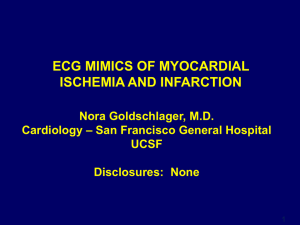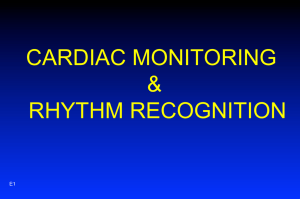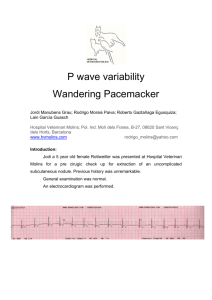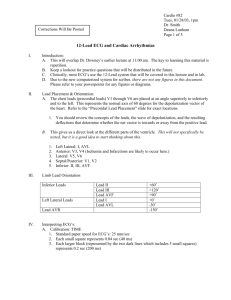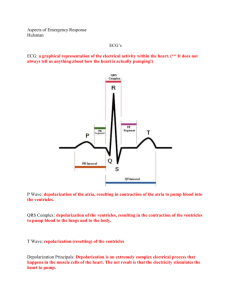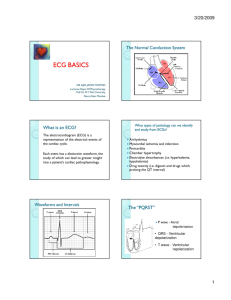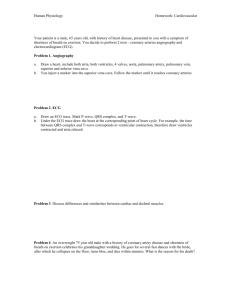EKG Basics
advertisement
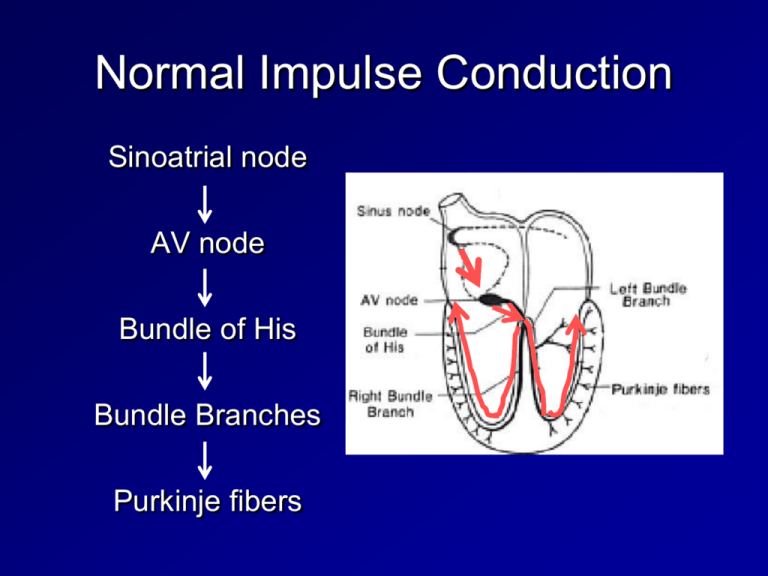
Normal Impulse Conduction Sinoatrial node AV node Bundle of His Bundle Branches Purkinje fibers The Normal Conduction System What is an EKG? The electrocardiogram (EKG) is a representation of the electrical events of the cardiac cycle. What types of pathology can we identify and study from EKGs? Arrhythmias Myocardial ischemia and infarction Pericarditis Chamber hypertrophy Electrolyte disturbances (i.e. hyperkalemia, hypokalemia) Drug toxicity (i.e. digoxin and drugs which prolong the QT interval) Waveforms and Intervals Impulse Conduction & the ECG Sinoatrial node AV node Bundle of His Bundle Branches Purkinje fibers The “PQRST” P wave - Atrial depolarization • QRS - Ventricular depolarization • T wave - Ventricular repolarization The PR Interval Atrial depolarization + delay in AV junction (AV node/Bundle of His) (delay allows time for the atria to contract before the ventricles contract) Pacemakers of the Heart SA Node - Dominant pacemaker with an intrinsic rate of 60 - 100 beats/minute. AV Node - Back-up pacemaker with an intrinsic rate of 40 - 60 beats/minute. Ventricular cells - Back-up pacemaker with an intrinsic rate of 20 - 45 bpm. The ECG Paper Horizontally – One small box - 0.04 s – One large box - 0.20 s Vertically – One large box - 0.5 mV EKG Leads Leads are electrodes which measure the difference in electrical potential between either: 1. Two different points on the body (bipolar leads) 2. One point on the body and a virtual reference point with zero electrical potential, located in the center of the heart (unipolar leads) EKG Leads The standard EKG has 12 leads: 3 Standard Limb Leads 3 Augmented Limb Leads 6 Precordial Leads The axis of a particular lead represents the viewpoint from which it looks at the heart. Rhythm Analysis Step 1: Step 2: Step 3: Step 4: Step 5: Step 6: Calculate rate. Determine axis Determine regularity. Assess the P waves. Determine PR interval. Determine QRS duration. Standard Limb Leads Standard Limb Leads Augmented Limb Leads All Limb Leads Precordial Leads Precordial Leads Summary of Leads Bipolar Limb Leads Precordial Leads I, II, III - (standard limb leads) Unipolar aVR, aVL, aVF (augmented limb leads) V1-V6 Anatomic Groups (Septum) Anatomic Groups (Anterior Wall) Anatomic Groups (Lateral Wall) Anatomic Groups (Inferior Wall) Anatomic Groups (Summary) Rule of 300 Take the number of “big boxes” between neighboring QRS complexes, and divide this into 300. The result will be approximately equal to the rate What is the heart rate? www.uptodate.com (300 / 6) = 50 bpm What is the heart rate? www.uptodate.com (300 / ~ 4) = ~ 75 bpm What is the heart rate? (300 / 1.5) = 200 bpm The Rule of 300 It may be easiest to memorize the following table: # of big boxes Rate 1 300 2 150 3 100 4 75 5 60 6 50 10 Second Rule As most EKGs record 10 seconds of rhythm per page, one can simply count the number of beats present on the EKG and multiply by 6 to get the number of beats per 60 seconds. This method works well for irregular rhythms. What is the heart rate? The Alan E. Lindsay ECG Learning Center ; http://medstat.med.utah.edu/kw/ecg/ 33 x 6 = 198 bpm The QRS Axis The QRS axis represents the net overall direction of the heart’s electrical activity. Abnormalities of axis can hint at: Ventricular enlargement Conduction blocks (i.e. hemiblocks) The QRS Axis By near-consensus, the normal QRS axis is defined as ranging from -30° to +90°. -30° to -90° is referred to as a left axis deviation (LAD) +90° to +180° is referred to as a right axis deviation (RAD) Determining the Axis The Quadrant Approach The Equiphasic Approach Determining the Axis Predominantly Positive Predominantly Negative Equiphasic The Quadrant Approach 1. Examine the QRS complex in leads I and aVF to determine if they are predominantly positive or predominantly negative. The combination should place the axis into one of the 4 quadrants below. The Quadrant Approach 2. In the event that LAD is present, examine lead II to determine if this deviation is pathologic. If the QRS in II is predominantly positive, the LAD is non-pathologic (in other words, the axis is normal). If it is predominantly negative, it is pathologic. Quadrant Approach: Example 1 The Alan E. Lindsay ECG Learning Center http://medstat.med.utah. edu/kw/ecg/ Negative in I, positive in aVF RAD Quadrant Approach: Example 2 The Alan E. Lindsay ECG Learning Center http://medstat.med.utah. edu/kw/ecg/ Positive in I, negative in aVF Predominantly positive in II Normal Axis (non-pathologic LAD) The Equiphasic Approach 1. Determine which lead contains the most equiphasic QRS complex. The fact that the QRS complex in this lead is equally positive and negative indicates that the net electrical vector (i.e. overall QRS axis) is perpendicular to the axis of this particular lead. 2. Examine the QRS complex in whichever lead lies 90° away from the lead identified in step 1. If the QRS complex in this second lead is predominantly positive, than the axis of this lead is approximately the same as the net QRS axis. If the QRS complex is predominantly negative, than the net QRS axis lies 180° from the axis of this lead. Equiphasic Approach: Example 1 The Alan E. Lindsay ECG Learning Center ; http://medstat.med.utah.edu/kw/ecg/ Equiphasic in aVF Predominantly positive in I QRS axis ≈ 0° Equiphasic Approach: Example 2 The Alan E. Lindsay ECG Learning Center ; http://medstat.med.utah.edu/kw/ecg/ Equiphasic in II Predominantly negative in aVL QRS axis ≈ +150° Step 2: Determine regularity R R Look at the R-R distances (using a caliper or markings on a pen or paper). Regular (are they equidistant apart)? Occasionally irregular? Regularly irregular? Irregularly irregular? Interpretation? Regular Step 3: Assess the P waves Are there P waves? Do the P waves all look alike? Do the P waves occur at a regular rate? Is there one P wave before each QRS? Interpretation? Normal P waves with 1 P wave for every QRS Step 4: Determine PR interval Normal: 0.12 - 0.20 seconds. (3 - 5 boxes) Interpretation? 0.12 seconds Step 5: QRS duration Normal: 0.04 - 0.12 seconds. (1 - 3 boxes) Interpretation? 0.08 seconds Rhythm Summary Rate Regularity P waves PR interval QRS duration Interpretation? 90-95 bpm regular normal 0.12 s 0.08 s Normal Sinus Rhythm The QRS Complex with Interval and Segment Measurements ECG Paper and related Heart Rate & Voltage Computations Arrhythmia Formation Arrhythmias can arise from problems in the: • Sinus node • Atrial cells • AV junction • Ventricular cells SA Node Problems The SA Node can: fire too slow fire too fast Sinus Bradycardia Sinus Tachycardia Sinus Tachycardia may be an appropriate response to stress. Atrial Cell Problems Atrial cells can: fire occasionally from a focus Premature Atrial Contractions (PACs) fire continuously due to a looping re- Atrial Flutter entrant circuit AV Junctional Problems The AV junction can: fire continuously Paroxysmal due to a looping Supraventricular re-entrant circuit Tachycardia block impulses AV Junctional Blocks coming from the SA Node Rhythm #1 • • • • • Rate? Regularity? P waves? PR interval? QRS duration? 30 bpm regular normal 0.12 s 0.10 s Interpretation? Sinus Bradycardia Rhythm #2 • • • • • Rate? Regularity? P waves? PR interval? QRS duration? 130 bpm regular normal 0.16 s 0.08 s Interpretation? Sinus Tachycardia Premature Beats Premature Atrial Contractions (PACs) Premature Ventricular Contractions (PVCs) Rhythm #3 • • • • • Rate? Regularity? P waves? PR interval? QRS duration? 70 bpm occasionally irreg. 2/7 different contour 0.14 s (except 2/7) 0.08 s Interpretation? NSR with Premature Atrial Contractions Premature Atrial Contractions Deviation from NSR – These ectopic beats originate in the atria (but not in the SA node), therefore the contour of the P wave, the PR interval, and the timing are different than a normally generated pulse from the SA node. Rhythm #4 • • • • • Rate? Regularity? P waves? PR interval? QRS duration? 60 bpm occasionally irreg. none for 7th QRS 0.14 s 0.08 s (7th wide) Interpretation? Sinus Rhythm with 1 PVC Ventricular Conduction Normal Abnormal Signal moves rapidly through the ventricles Signal moves slowly through the ventricles AV Nodal Blocks 1st Degree AV Block 2nd Degree AV Block, Type I 2nd Degree AV Block, Type II 3rd Degree AV Block Rhythm #10 • • • • • Rate? Regularity? P waves? PR interval? QRS duration? 60 bpm regular normal 0.36 s 0.08 s Interpretation? 1st Degree AV Block 1st Degree AV Block Etiology: Prolonged conduction delay in the AV node or Bundle of His. Rhythm #11 • • • • • Rate? Regularity? P waves? PR interval? QRS duration? 50 bpm regularly irregular nl, but 4th no QRS lengthens 0.08 s Interpretation? 2nd Degree AV Block, Type I Rhythm #12 • • • • • Rate? Regularity? P waves? PR interval? QRS duration? 40 bpm regular nl, 2 of 3 no QRS 0.14 s 0.08 s Interpretation? 2nd Degree AV Block, Type II 2nd Degree AV Block, Type II Deviation from NSR – Occasional P waves are completely blocked (P wave not followed by QRS). Rhythm #13 • • • • • Rate? Regularity? P waves? PR interval? QRS duration? 40 bpm regular no relation to QRS none wide (> 0.12 s) Interpretation? 3rd Degree AV Block 3rd Degree AV Block Deviation from NSR – The P waves are completely blocked in the AV junction; QRS complexes originate independently from below the junction. Supraventricular Arrhythmias Atrial Fibrillation Atrial Flutter Paroxysmal Supraventricular Tachycardia Rhythm #5 • • • • • Rate? Regularity? P waves? PR interval? QRS duration? 100 bpm irregularly irregular none none 0.06 s Interpretation? Atrial Fibrillation Atrial Fibrillation Deviation from NSR – No organized atrial depolarization, so no normal P waves (impulses are not originating from the sinus node). – Atrial activity is chaotic (resulting in an irregularly irregular rate). – Common, affects 2-4%, up to 5-10% if > 80 years old Rhythm #6 • • • • • Rate? Regularity? P waves? PR interval? QRS duration? 70 bpm regular flutter waves none 0.06 s Interpretation? Atrial Flutter Rhythm #7 • • • • • Rate? Regularity? P waves? PR interval? QRS duration? 74 148 bpm Regular regular Normal none 0.16 s none 0.08 s Interpretation? Paroxysmal Supraventricular Tachycardia (PSVT) PSVT Deviation from NSR – The heart rate suddenly speeds up, often triggered by a PAC (not seen here) and the P waves are lost. Ventricular Arrhythmias Ventricular Tachycardia Ventricular Fibrillation Rhythm #8 • • • • • Rate? Regularity? P waves? PR interval? QRS duration? 160 bpm regular none none wide (> 0.12 sec) Interpretation? Ventricular Tachycardia Ventricular Tachycardia Deviation from NSR – Impulse is originating in the ventricles (no P waves, wide QRS). Rhythm #9 • • • • • Rate? Regularity? P waves? PR interval? QRS duration? none irregularly irreg. none none wide, if recognizable Interpretation? Ventricular Fibrillation Ventricular Fibrillation Deviation from NSR – Completely abnormal. Diagnosing a MI To diagnose a myocardial infarction you need to go beyond looking at a rhythm strip and obtain a 12-Lead ECG. 12-Lead ECG Rhythm Strip ST Elevation One way to diagnose an acute MI is to look for elevation of the ST segment. ST Elevation (cont) Elevation of the ST segment (greater than 1 small box) in 2 leads is consistent with a myocardial infarction. Now, where do you think this person is having a myocardial infarction? Inferior Wall MI This is an inferior MI. Note the ST elevation in leads II, III and aVF. How about now? Anterolateral MI This person’s MI involves both the anterior wall (V2-V4) and the lateral wall (V5-V6, I, and aVL)! RIGHT ATRIAL ENLARGEMENT Right atrial enlargement – Take a look at this ECG. What do you notice about the P waves? The P waves are tall, especially in leads II, III and avF. Ouch! They would hurt to sit on!! Right atrial enlargement – To diagnose RAE you can use the following criteria: II V1 or V2 P > 2.5 mm, or P > 1.5 mm > 1 ½ boxes (in height) > 2 ½ boxes (in height) Remember 1 small box in height = 1 mm A cause of RAE is RVH from pulmonary hypertension. Left atrial enlargement – Take a look at this ECG. What do you notice about the P waves? Notched Negative deflection The P waves in lead II are notched and in lead V1 they have a deep and wide negative component. Left atrial enlargement – To diagnose LAE you can use the following criteria: II V1 > 0.04 s (1 box) between notched peaks, or Neg. deflection > 1 box wide x 1 box deep Normal LAE A common cause of LAE is LVH from hypertension. Left Ventricular Hypertrophy Compare these two 12-lead ECGs. What stands out as different with the second one? Normal Left Ventricular Hypertrophy Answer: The QRS complexes are very tall (increased voltage) Left Ventricular Hypertrophy Criteria exists to diagnose LVH using a 12-lead ECG. – For example: The R wave in V5 or V6 plus the S wave in V1 or V2 exceeds 35 mm. Right ventricular hypertrophy – Take a look at this ECG. What do you notice about the axis and QRS complexes over the right ventricle (V1, V2)? There is right axis deviation (negative in I, positive in II) and there are tall R waves in V1, V2. Right ventricular hypertrophy – To diagnose RVH you can use the following criteria: V1 Right axis deviation, and R wave > 7mm tall A common cause of RVH is left heart failure. Right ventricular hypertrophy – Compare the R waves in V1, V2 from a normal ECG and one from a person with RVH. – Notice the R wave is normally small in V1, V2 because the right ventricle does not have a lot of muscle mass. – But in the hypertrophied right ventricle the R wave is tall in V1, V2. Normal RVH Left ventricular hypertrophy – Take a look at this ECG. What do you notice about the axis and QRS complexes over the left ventricle (V5, V6) and right ventricle (V1, V2)? The deep S waves seen in the leads over the right ventricle are created because the heart is depolarizing left, superior and posterior (away from leads V1, V2). There is left axis deviation (positive in I, negative in II) and there are tall R waves in V5, V6 and deep S waves in V1, V2. Left ventricular hypertrophy – To diagnose LVH you can use the following criteria*: avL R in V5 (or V6) + S in V1 (or V2) > 35 mm, or R > 13 mm S = 13 mm * There are several other criteria for the diagnosis of LVH. R = 25 mm A common cause of LVH is hypertension. Bundle Branch Blocks So, conduction in the Bundle Branches and Purkinje fibers are seen as the QRS complex on the ECG. Therefore, a conduction block of the Bundle Branches would be reflected as a change in the QRS complex. Right BBB Bundle Branch Blocks With Bundle Branch Blocks you will see two changes on the ECG. 1. QRS complex widens (> 0.12 sec). 2. QRS morphology changes (varies depending on ECG lead, and if it is a right vs. left bundle branch block). Right Bundle Branch Blocks What QRS morphology is characteristic? For RBBB the wide QRS complex assumes a unique, virtually diagnostic shape in those leads overlying the right ventricle (V1 and V2). V1 “Rabbit Ears” RBBB Left Bundle Branch Blocks What QRS morphology is characteristic? For LBBB the wide QRS complex assumes a characteristic change in shape in those leads opposite the left ventricle (right ventricular leads - V1 and V2). Normal Broad, deep S waves HYPERKALEMIA HYPERKALEMIA SEVERE HYPERKALEMIA HYPOKALEMIA HYPOKALEMIA HYPOKALEMIA HYPERCALCEMIA HYPOCALCEMIA ACUTE PERICARDITIS ACUTE PERICARDITIS CARDIAC TAMPONADE PERICARDIAL EFFUSIONElectrical alterans HYPOTHERMIA-OSBORNE WAVE HYPOTHERMIAGiant Osborne waves
